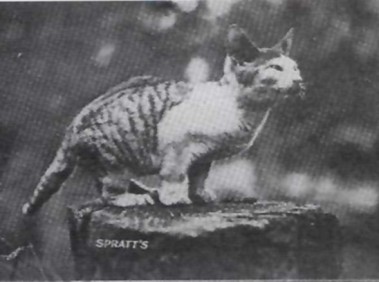 Australian female cat from the late 1800s/early 1900s with short forelegs. Possibly the first documented short-legged cat.
Australian female cat from the late 1800s/early 1900s with short forelegs. Possibly the first documented short-legged cat.
SHORT-LEGGED CATS
Although often thought of as a new development in cats, short-legged cats have been reported several times in the last century. Many of those cats bred for several generations before slipping into obscurity. The only difference with the modern day situation is that breeders have now taken this trait and developed it into a number of breeds.
The first accounts I have of short-legged cats include sightings of short-legged feral cats in England during the 1930s and, in 1931, a hereditary short-legged condition was described by Schwangart and Grau.
EARLY SHORT-LEGGED MUTATIONS
|
|
The "Flatbush Mutation" was a localised variety noted (1950s?) in Brooklyn, New York, in the Vanderveer housing project in the neighbourhood of Flatbush (the housing project comprised numerous interconnected basements, bomb shelters and underground garages). A distinctive, peculiar-looking bicolour female stray cat appeared among the Flatbush stray population. She had short limbs, a short tail, a small, low-slung body and a narrow, slightly flattened head with short ears. More cats and kittens with this look appeared as the female produced kittens and several generations of Flatbush cats arose. This was probably a highly local, spontaneous mutation reinforced or fixed by inbreeding i.e. a breed began to evolve in urban Brooklyn. Unfortunately the mutation was lost probably due to new blood arriving in the area in the form of other strays or unneutered pet cats.
In "Zoologischer Anzeiger" in 1956, author Max Egon Thiel of Hamburg, Germany, described a cat that he had seen in Stalingrad in 1953. The cat had unusually short legs and was playing with its normal littermates. He had seen it sitting on its hind legs like with its front legs in the air so he called it the "Stalingrad Kangaroo Cat". The day before he was to return to Germany, the cat was taken away by a Russian physician and nothing more is known of it.
A reader in Pennsylvania wrote to "Our Cats" (Dec 1958) regarding an abnormality in his local cat population. He had frequently observed a local variation in cats in Lancaster County which must be a dominant trait as entire litters occurred with cats whose legs were markedly shorter than normal. The short-legged cats walked with a crouch, and scuttled rather than ran. It was not due to any dietary deficiency as the bone structure was sound, and the cats seemed perfectly healthy. This may have been the first mention of the "Munchkin" (as it was later known) in a British cat magazine.
Kangaroo cats apparently disappeared in Europe, but the mutation cropped up again in New England in the 1970’s and then in Louisiana, USA in 1983 and went on to become the Munchkin breed. Since the famous 1983 Munchkin and her offspring, similar unrelated cats have been found throughout the USA and other countries as spontaneous mutations born to normal parents. The publicity the Munchkin received probably made many cat lovers more aware of the mutation and more likely to report it. Munchkins have shortening and bowing of the long bones of the legs, much like Dachshund and Corgi dogs and much as Williams-Jones described in 1944. Unlike cats whose forelimbs are shorened through Radial Hypoplasia, Munchkins have a good quality of life and no locomotory problems except for the inability to jump great heights. Contrary to some reports, they are not "unable to jump"! They are, however, prone to two abnormalities: lordosis (curvature of the spine causing chest compression) and pectus (also affecting the chest). In addition, litter sizes are smaller than average, suggesting that some embryos die early.
Short-leg mutations will continue to crop up. Some affect all 4 limbs while others affect the front limbs only. This Mexican stray "Pedro", photographed in 1993 has normal length hind legs, but his forelegs are shortened, thickened and appeared slightly twisted with the paws turned outwards.
|
|
|
WHAT CAUSES SHORT-LEGGED CATS?
It is impossible to say for sure which of several possible mutatin the eary "Kangaroo cats" actually had. The term "foreleg micromelia" suggests a mild form of the usually crippling condition Radial Hypoplasia (Polydactyl Cats), but the description of their smooth ferret-like gait and the apparent absence of extra toes does not support this diagnosis. They probably had one of the many forms of dwarfism that occurs in mammals. In contrast, modern Munchkins have "foreleg and hindleg micromelia".
The most common (and easily recognisable) short-limbed condition is achondroplasia dwarfism which shortens the long bones of the limbs while leaving the trunk (body) and head unchanged.. Achondroplasia dwarfism is characterised by abnormal body proportions. Achondroplasia dwarfism is the result of a dominant gene affecting the hormones which control bone growth. Typically, the growth of the limbs is stunted, while the size of the trunk and mental capacity are normal. It causes abnormally short and deformed limbs; this is most noticeable in short-legged dog breeds where the limbs are bowed or twisted. It also typically produces a large head with undershot (bulldog) jaw and crowded, misaligned teeth. Other cranial problems may occur due to the abnormal head shape. The limbs are frequently bowed which may result in poorly articulating joints. The vertebrae may also be affected. Although most affected cats are mentally normal, their abnormal body proportions may result in slow development in early kittenhood. The large head may result in kittens being delivered by caesarian section as they are unable to pass through the birth canal. Stuck kittens are likely to die and would likely cause the mother to die.
In the Munchkin; these short limbs are the distinguishing feature of the breed and the other deformities associated with achondroplasia are avoided (as far as possible) by careful selective breeding, avoiding breeding those individuals which have spine or chest deformities. Achondroplasia is typically associated with a large or abnormal head, but Munchkins do not have this trait, suggesting a different condition that mimics achondroplasia, most likely pseudochondroplasia.
Achondroplasia also occurs at random in the feline population due to mutation. It is a variable condition ranging from "nearly normal" to crippling with all legs severely deformed. The forelegs are usually more severely affected than the hindlegs. In animals this form of dwarfism ranges from mildly disabling to crippling if only one copy of the gene is inherited. If two copies of the gene are inherited, the trait is lethal and the embryos are either reabsorbed early on in pregnancy (this is the case with cats) or stillborn.
There are almost certainly other dwarf conditions in cats, although they may not have not been identified as distinct from the Munchkin mutation. Acromesomelia (acromesomelic dysplasia) is characterized by short arms, legs, and fingers, and a slightly enlarged head. Hypochondroplasia looks like mild achondroplasia, but is genetically different. Its effects are less pronounced and there are fewer associated health problems. In species where dwarfism is poorly documented, it is often misdiagnosed as achondroplasia. Pseudoachondroplasia also mimics achondroplasia, but leaves the head size and facial features unaffected and is associated with osteoarthritis and other orthopaedic problems.
MODERN DWARF BREEDS
MUNCHKIN
Although short-legged cats have occurred time and time again all around the world and been reported as early as the 1930s, the Munchkin breed derives from a pregnant short-legged black stray found in 1983 by Sandra Hochendel in Rayville,Louisiana. Hochendel found two short-legged strays under a pickup truck where they had been cornered by a dog. Both cats were pregnant. The grey female, Blueberry, was given away, but Hochendel kept the black cat and nameed her Blackberry. She called Blueberry and Blackberry "Munchkins" after the small folk in the Wizard of Oz story. When Blackberry's kittens arrived, almost half of them had short legs and the ferret-like gait that results from a long low body on short limbs. Hochendel gave a short-legged son of Blackberry, called Toulouse, to Kay LaFrance, who established a free-breeding colony of Munchkins on her Monroe, Louisiana plantation. Blackberry went on to have several litters, each including both short-legged and long-legged kittens. Sadly Blackberry vanished and Hochendel feared the trait was lost. Luckily the trait survived through Toulouse's offspring. Another name for the breed was the Louisiana Creole Cat.
Since 1990, 30 or more unrelated short-legged cats were identified. One such discovery was a short-legged black kitten called "Sam I Am" born in ea derelict truck in East Haven, Connecticut. Sam was adopted by Marian Brezicki and Mark DeNegre. The vet informd that Sam was a Munchkin-type cat and the couple registered him with TICA as a foundation stud cat (a foundation cat is one that has the disired attributes of a breed in its early stages, but is of unknown pedigree).Munchkin type cats had been observed in 15 US states and some of these were included in the Munchkin breeding programme. Being found in different geographical locations meant the cats were unrelated to Hochendel's cat and their inclusion prevented inbreeding. This means that the Munchkin is a natural, rather than a man-made, breed. Not all spontaneous Munchkins can be used for breeding as the story of "Tellie" (foot of page) demonstrates. Although many people had reservations about the mutation, geneticist Dr Solveig championed the breed and it was fully recognised by TICA in the USA in 2002.
|
|
|
|
|
Munchkin photos courtesy of Paul McSorley, www.minskin.com |
||
Munchkins are bred to other Munchkins and also to long-legged domestic ats to ensure a wide a healthy gene pool. Because the gene controlling the trait is dominant, Munchkin-to-Munchkin breedings can also result in long-legged variant offspring. The long-legged kittens are registered as Munchkins and are used in breeding programmes. The influence of a variety of domestic cats in the breeding programme has introduced all colours and patterns and both long and short hair. It also means that Munchkins have good health and sweet temperaments.
Because of their low-to-the-ground build, Munchkins corner well (they are described as "having great road-holding") and they run and climb without problem. Contrary to many reports, Munchkins can jump, but their short legs means they don't jump much higher than the average Persian cat. This means they can't jump up onto high surfaces. Many like to sit upright like prairie dogs and they are also described as being magpies - stealing and hiding toys and trinkets, often underneath furniture.
The Munchkin's short legs are due to dominant gene achondroplasia (or mimic condition) that stunts the growth of the long bones and causes them to bow slightly. They are therefore normal-sized cats with short legs. Because of their resemblance to Dachshunds and Corgis, Munchkins were initially considered to be at risk of back and joint problems. Many were opposed to them because they believed the cats could not run or jump normally. Munchkins run with a ferret-like gait and can jump, albeit not very high. Because the cat's spine is different to the dog's spine, the feared spinal problems have not shown up either. They have shorter, thicker leg bones than long-legged cats, but the proportions of their feet, tail, spine or skull are unaffected. Breed standards now require that the feet do not point outwards.
Although they are healthy, like many breeds a few individuals seem to have defects although the prevalence of these defects are not yet known (they are uncommon when compared to defects in other recognised breeds such as the Scottish Fold and the Manx). One potential problem is lordosis, an excessive dip in the spine behind the shoulders. The problem seems to relate to the muscles that hold the spine in place rather than to the bony structure of the spine itself. This dip means the chest is not as deep as it should be and there is compression of the heart and lungs. Another problem sometimes seen is pectus which also affects the chest. Although not all breeders accept that these problems exist as a result of the Munchkin trait (stating that any cat of any breed can have the same problems entirely at random), it may be possible to blood test cats to eliminate carriers from the breed.
Munchkin litters are often smaller than average cat litters, suggesting that some embryos die early and are reabsorbed by the mother (probably where the embryo inherits two copies of the gene i.e. homozygous). The remaining offspring have few, if any, health issues Breeders are careful to avoid breeding from cats with lordosis or pectus, therefore this form of dwarfism is considered cosmetic.
Once the gene for short legs has appeared, it is possible to introduce it into other breeding programs. Because the trait is dominant, long-legged variants will occur in Munckins and all derivative breeds (this is because the recessive long-legged trait is carried in hidden form by many short-legged cats).
MINSKIN
Once the gene for short legs appeared in the Munchkin, it was possible to combine with other traits, including hairlessness. introduce it into other breeding programs. The Minskin is neither a short-legged Sphynx nor a hairless Munchkin, but has its own unique look strongly influenced by its American Burmese ancestry. The Minskin began development in 1998 in Boston, Massachusetts and the first cat of the desired Minskin type was born in July 2000. By 2005, about 50 breed-standard Minskins existed with a further 100 Minskin variants (short-legged cats can produce long-legged offspring). TICA classify it as a hybrid breed as it is derived from pre-existing breeds. It gets its name for "Min" (miniature legs) and "skin" (sparse coat and hairless belly).
|
|
|
|
|
Minskin photos courtesy of Paul McSorley, www.minskin.com |
||
The Minskin, developed by Paul McSorley, combines the Munchkin's short legs with the Canadian Sphynx's hairlessness. Paul was one of the first few to work with Munchkins in the early 1990's, having already established a line of award winning American Burmese and a line of Tonkinese. The Burmese (the American Burmese being cobbier than the European Burmese), but not the Tonkinese, were crossed to Munchkins in developing the Minskin. The Sphynx and closely related Devon Rex (about 50/50 ratio) were used only to introduce their distinctive coat genes to produce the unique Minskin “fur points” that are the breed’s trademark. It was this unique "fur-pointed" coat description that was the “unique trait” required for recognition. While Sphynx are bald and Devon Rex are fully rex coated, the in-between kittens ("fuzzies") were either culled or homed as pets. The Minskin is therefore a mix of four breeds in the following order of importance: 1) Munchkin; 2) Burmese; 3) Devon Rex; 4) Canadian Sphynx.
Their Sphynx ancestry is often over-stated, and a great deal of credit must go to the American Burmese. The first ever Minskin was Rory, a Sphynx hybrid, but he was infertile. The second ever Minskin was Lola who was a Devon Rex hybrid and who is behind most modern Minskin lines. The initial Minskin breedings were Sphynx x (Munchkin x Burmese), but I the Burmese and Devon Rex were instrumental developing the Minskin. The Minskin may only be outcrossed to non-breed domestic shorthairs (and not to Sphynxes) to widen the gene pool.
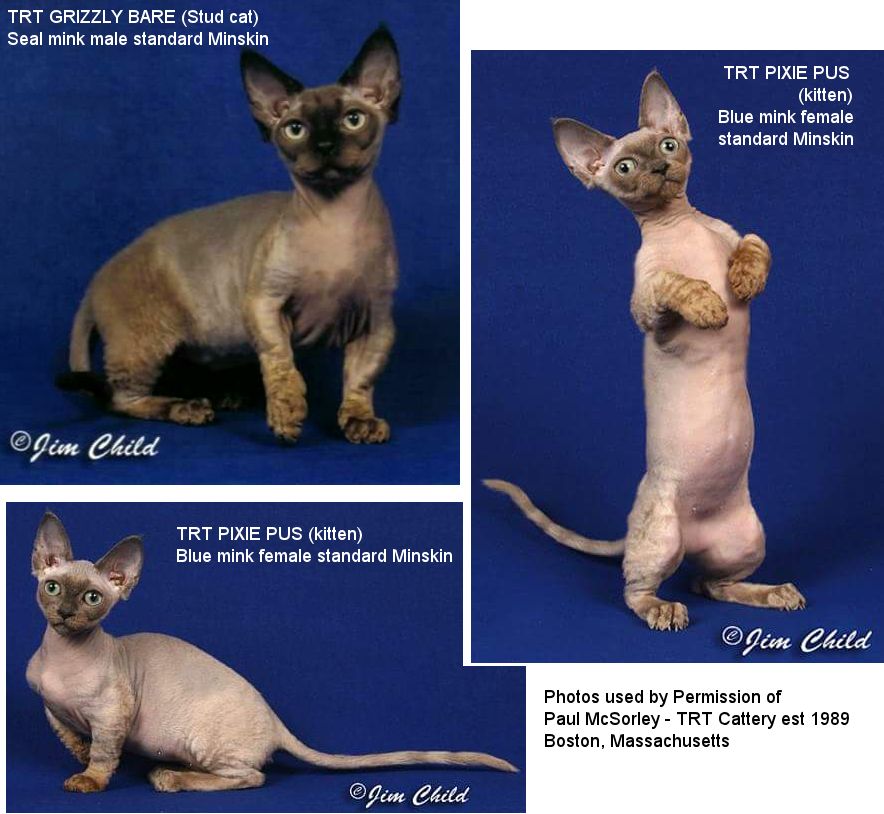
The conformation is semi-cobby and the coat type is "cashmere" with furred points. Unlike the Sphynx parent, Minskins are not hairless. "Fur-points" aredefined by the density of the fur on the cats' outer extremities in comparison to the rest of the body. The facial mask, ears, legs and tail have closely packed fur which has a textured satin sheen, especially on the legs. The body is sparser coated and has the look and feel of a soft cashmere garment. The fur-point trait is a recessive trait involving polygenes (multiple genes) that govern the actual length of the coat. The coat is described as non-shed which means minimal or barely noticeable shedding (moulting). As with the Sphynx, Minskins feel warm to the touch. All colours and patterns are allowed and colourpoint is a favourite.
The Minskin achieved Preliminary New Breed status with TICA but, ten years later, in 2019, it was demoted to Registration Only, during which time the very similar Bambino sought registration status with TICA in spite of protests from the Minskin community that the Bambino was genetically identical to the pre-existing Minskin. Bambinos were easier to breed by repeated outcrossing to Sphynx. By that time, TICA had changed the rules, prohibiting recognition of further “Munchkin-ised” breeds, but WCF (World Cat Federation) which is very active in Russia and neighbouring countries and which is more accepting of the breed . Valentina's Pride Cattery in Moscow, Russia, in particular has been developing the breed based on a Burmese outcross line.
The semi-cobby conformation means Minskins are noticeably stocky and small with a rounded head. The eyes are large and round and the face has a sweet expression and a "hobbit-like" appearance. The appearance remains kitten-like, even when fully grown into a small/medium size cat. As with the Munchkin parent, the short stature and does not impair their mobility or quality of life. As well as having a sweet appearance, the Minskin has a sweet temperament. Minskins are described as being outgoing, sweet, playful (but not destructive) and people-oriented.
This breed has a rounded head, wider than it is long, with large, round, wide-set eyes and large, open round-tipped ears, all of which give an open and alert expression. The chin is firm and strong, the muzzle is short and broad and the whisker pads are prominent. The nose is neither straight nor humped and there is a visible stop in the profile. It is semi-cobby, but may appear longer due to short legs. It is stocky, sturdy and well-muscled, definitely not fine-boned. he back is straight, but there may be a slight rise from shoulders to tail as the back legs are, or may appear to be, slightly longer than the front legs. The chest is broad, strong and well-muscled. The tail is slightly longer than the body.
The coat is distinctive. It is short (fuzz or down) with “fur points” - short, soft, closely packed fur, covering the entire mask, ears, legs, tail and scrotum. The body is sparsely coated. The leg fur may extend up to the shoulders, hips and the buttocks. The temples (forehead in front of ears) are noticeably sparse between the top of the eyes to the frontal base of the ear. Ear muffs may or may not be present. Whiskers may be present, sparse, broken or absent. The neck, chest and abdomen may appear hairless but are covered in a very thin, fine down. Both adults and kittens may have some wrinkling to the skin, this being more apparent in kittens. The fur texture is rippled and soft like a fine cashmere garment.
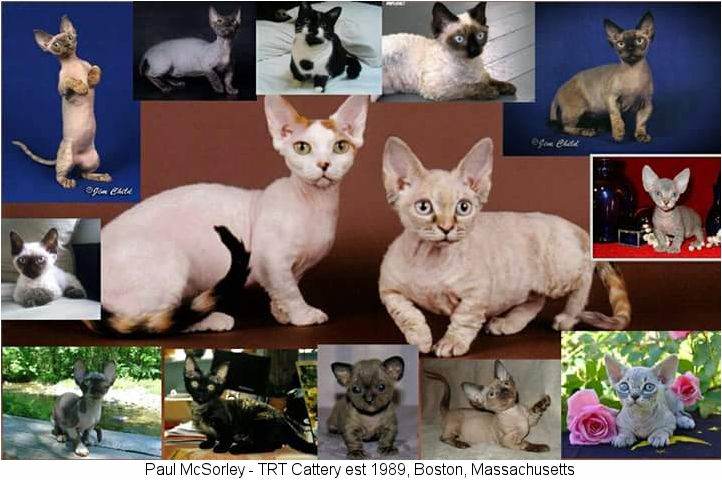
TRT Vanta, the short-haired Minskin variant shows an interesting trait in the breed - coarse hair in carriers of the fur-pinted trait. Panda (the black-and-white cat , top centre in collage) was the first coated Minskin carrying the fur-pointed trait related to Devon Rex and Sphynx Hairlessness, and she had noticeably coarse fur texture; not wire-haired, but definitely lacking in sheen and lustre. Her unusual "rough textured coat" was observed by TICA Judge and geneticist Dr. Solveig Pflueger. This "dull coat" was commonly seen in coated cats carrying the recessive gene for rex coat/fur-points. This was a good indicator for identifying which coated cats carried the recessive fur-pointed trait and would produce some fur-pointed kittens when bred together. It could also indicate which of the coated kittens did not have the recessive gene. This is important when outcrossing to American Burmese to widen the gene pool. The black short-coated kitten, Vanta, has the dull coat indicative of the presence of the recessive fur-pointed trait.

(This is similar to the situation with the (dominant) Russian Hairless gene where breeders can predict the texture of the residual hair and posit 2 modifiers – one that weakens hairlessness and one that improves hairlessness. In a coated breed, the now-extinct Bramble, the preferred texture was brush-coated, showing that cats do have genes that affect the coat texture. In addition, while most Sphynx are due to one gene mutation, but there are other hairless mutations in the breed and a few phenotypic Sphynx, born from pedigree Sphynx, have tested negative for the most common mutation. In pre-DNA test days, spontaneous hairless cats were added to the breed, but might have had a different mutation. )
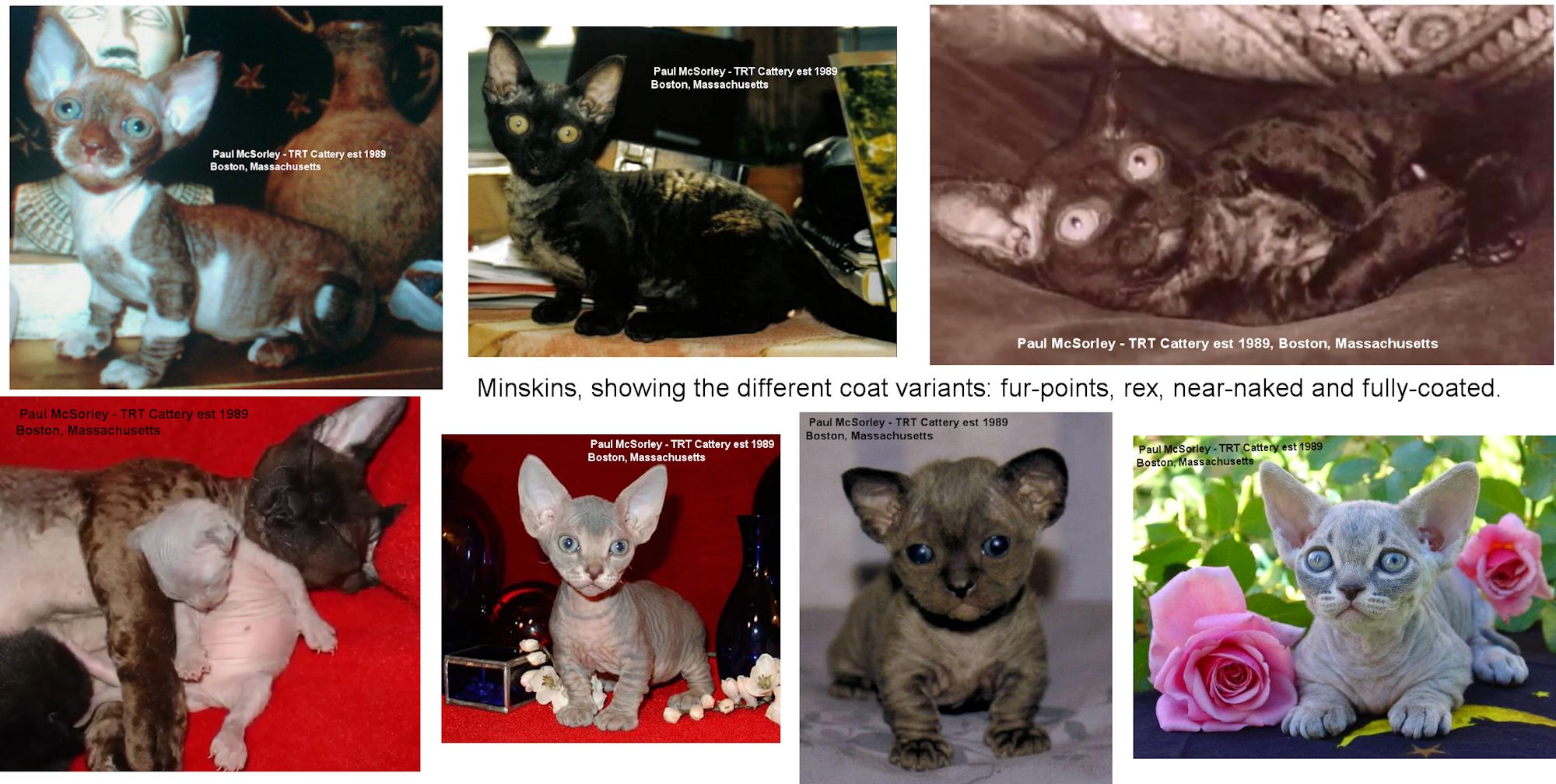
BAMBINO
Another hybrid of Sphynx and Munchkin has produced the Bambino (Italian for "baby" and alludes to their mischievous personalities) with a wedge-shaped head, wide set eyes, short, squarish muzzle and lynx-tipped ears set well onto the top of the head rather than flared outwards. It is a muscular, medium-boned cat. The coat varies from hairless to peach-fuzz and all colours and patterns are allowed. Bambino Long-Legs variants occur. Because it was easy to repeatedly outcross to Sphynx, these achieved higher numbers sooner than the Minksin.
SKOOKUM
Developed in 1998, the Skookum (apparently meaning "sweet") comes from crossing the Munchkin with the LaPerm. It was previously known as the LaMerm. It is described as the Shirley Temple of cats - short, sweet and curly-haired. The rex-type curly fur is low-shedding. Although both the LaPerm and Munchkin are recognised by TICA in the USA, this hybrid is not yet recognised. Skookums are playful and often described as natural clowns.
MINUET (FORMERLY "NAPLOEON")
Developed in 2002, the Minuet (formerly called the Napoleon Cat) is a hybrid (a breed developed from a deliberate cross between two existing breeds) between the Munchkin and the Persian/Exotic including the Himalayan (Colourpoint) Persian. Longhaired Munchkins already exist, but the Minuet combines traits from both breeds into a unique look. It is neither a short-legged Persian nor a bushy-furred Munchkin. The Minuet is a short-legged cat with heavy boning, round head, round eyes and a colourful coat. Its fur can be either long (like the Persian) or short like the Exotic. Its features are intermediate between the two parent breeds. A pure Minuet is 75% Persian/Exotic and 25% Munchkin. It does not have the snub nose, nor even the nose break above the nose, of the Persian, but at the same time it doesn't have the wedge-shaped head or walnut-shaped eyes of the Munchkin. As with other breeds derived from the Munchkin, long-legged variants also occur.
KINKALOW
A curl-eared Munchkin-type cat has been bred using crosses to the American Curl breed.
JAGUARUNDI CURL
The Jaguarundi Curl is bred to resemble the Jaguarundi. Munchkins (or other short-legged cats) have been crossed to Highland Lynx to give the head, small curled ears and polydactyl feet of the Highland Lynx combined with the short legs and long body of the Munchkin, however Jaguarundi Curls are bred to have a full-length tail like that of the Jaguarundi. Preferred patterns are solid colours or tawny (ticked) coats similar to those of the wild Jaguarundis; spotted/rosette markings (including sepia, snow and mink versions).
OTHER DERIVATIVES AND THE TICA RULING
There has been some interest in combining the Munchkin's short-legged trait with other Rex mutations, perhaps to create short-legged forms of the Cornish and Devon Rexes. The idea of Polydactyl Munchkins also attracted some interest. The Munch-Bob was posited as a Munchkin/Pixie-Bob cross that had a bobtail and polydactyly. It could also be crossed with one of the other bobtailed breeds to produce bobtailed Munchkins. The Munchamese was suggested as a short-legged Siamese rather than a colourpoint Munchkin; cats of this type were bred for a short while in South Carolina where they were known as Munchinese. The Elizabethan was reported as another breed being developed from the Munchkin, though I have no description. The Lambkin is a crossbreed of Selkirk Rex and Munchkin to produce a shortlegged cat with dense curls.
Sphynxkins were also mooted, being completely hairless and having Sphynx-like features, but the breeder was unable to obtain suitable breeding stock from either breed to make crosses. Two crosses that are discouraged are Munchkin/Scottish Fold (due to the skeletal problems found in the Scottish Fold) and Munchkin/Manx or "Manxkin" (due to spinal problems found in the Manx). Afficionadoes of the German-bred Pudelkatze (Poodle Cat - developed from crosses between Devon Rex and Scottish Fold) have suggested crossing it with short-legged cats to combine the traits of curled hair, folded ears and short legs into a "Poodlekin". All three traits are legally defined as harmful defects in Germany and the idea was never put into practice.
In 2006, TICA proposed to clamp down on certain breeding trends. Their Genetics Committee report stated: "The Committee proposes that TICA does not accept any proposed breeds for Registration Only status that do not exhibit novel mutations. The current mutations would be reserved for currently recognized breeds exclusively. This would end the seemingly endless applications for "munchkinized" new breeds, and then deter the inevitable introduction of "rexed", "Bob-tailed" and Poly-ed" everything else." They followed this in 2015 with a ruling that the breed that originally had the novel mutation "owns" that mutation and that, in future, derivative breeds would require the owning breeds permission to use it. This did not apply to short-legged breeds already in development. It was not clarified whether this ruling meant the genotype (the actual gene mutation found in the Munchkin) or the phenotype (the short-legged trait in general) was covered by this ruling. Would a spontaneous short-legged trait that occurred in a region without Munchkin cats (or derivative breeds) be subject to that restriction? Bear in mind that short-legged cats spontaneously appeared in Russia and England prior to the Munchkin breed.
The short-legged Genetta, developed in 2006, was bred from Bengal and Munchkin stock, though there were initially plans to incorporate Serval genes (perhaps through the Savannah breed). The aim is a short-legged breed with exotic spotted markings. It was developed to resemble the African Genet (which is not a true cat) and is intended to have black spots/rosettes on a butter/cream or silver-grey background, large rounded ears, thick, very long, black-ringed tail and long neck.
The Dwelf (2008) combines curled ears with hairlessness (the "Elf"), but added Munchkin and Highlander (a bobtailed, curl-eared polydactyl breed) to the mix. These combine hairlessness, curled ears and short legs.
The Scottish Kilt combines folded ears (from the Scottish Fold) with short legs, but raises serious concerns about bone, cartilage and joint health due to the side-effects of the fold gene.
The Jaguarundi Curl aimed to resemble the Jaguarundi. Short-legged cats were crossed to Highland Lynx. Initial crosses gave the head, small curled ears and polydactyl feet of the Highland Lynx combined with the short legs and long body of the Munchkin, however Jaguarundi Curls are bred to have full-length tails. Preferred patterns were solid colours or tawny (ticked) coats similar to those of the wild Jaguarundis; spotted/rosette markings (including sepia, snow and mink versions).
In 2009, came the Skinderlow, developed from the Skinderlop (Sphynx x Scottish Fold). The Skinderlow added short legs.
The Petit Teddy was a Munchkin x Siberian crossbreed.
RECENT SPONTANEOUS MUTATIONS
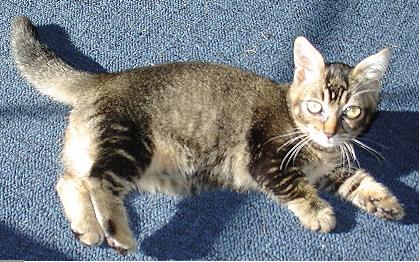
The following detailed account of a cat with a less benign form of achondroplasia (or mimic condition) is provided by Aimee Johnson in October 2003. Aimee has allowed me to use the information and photos to provided information other owners of similar random-bred cats. Unlike the apparently healthy Munchkins, "Tellie" suffers a number of health problems, some linked to his condition and others possibly due to inbreeding and birthing problems. At the time of this account, Tellie was four and a half months old.
Tellie, was born to a small, undernourished feral mother whose brother and father had mated with her. The mother's size may have led to a difficult birth for the kittens. Tellie's littermate, a brother, was normally proportioned and healthy, but was killed by a pit bull terrier. From birth, Tellie was less active than his brother and did not respond as much to stimuli; this may have been due to genetic retardation or oxygen starvation during birth.
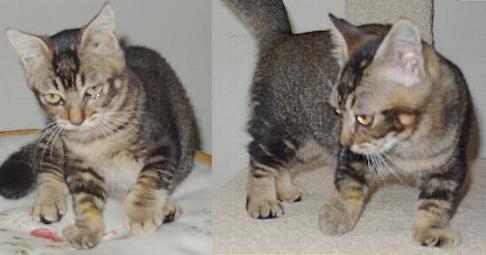
Tellie remained exceedingly small and has long-standing and often severe respiratory difficulties. He wheezes and snorts constantly; antibiotics help with the congestion but he breathes noisily and with difficulty. His eyes weep constantly, especially after he eats (which suggests some cranial deformities affecting nasal passages and tear ducts). He has a small ridge down his palate, and one vet speculated he would suffer various problems all of his life. At 14 weeks, Tellie broke his right front radius, though this healed in only 2 weeks. At fourteen weeks Tellie weighed 3 lbs, 8.5 oz and the vet noted a Munchkin-type condition. The vet who examined the x-rays noted that Tellie would be at a higher risk of breaking a disc in his back. This is because his shorter legs don't act as shock absorbers as efficiently as normal length legs, putting more strain on his back when he jumps down from surfaces. To prevent further broken bones in his legs and to reduce the likelihood of back damage, Aimee provided stools and ramps to those surfaces Tellie climbs onto so he doesn't have to jump down. Tellie is extremely rambunctious, curious, and full of energy. He likes to climb, but is hesitant of jumping down because the impact is not cushioned by his short legs.
In 2008, Jenny Stooksberry reported a short-legged stray cat hanging around a commercial truck rental business in Austin, Texas. Its legs were so short that its belly almost seemed to drag the ground. It would be unusual for a Munchkin to be kept as an indoor/outdoor pet, so it could be a stray or a spontaneous mutation.